IJCRR - 9(12), June, 2017
Pages: 49-53
Date of Publication: 24-Jun-2017
Print Article
Download XML Download PDF
Comparison of Discrete Wavelet Transform (DWT), Discrete Cosine Transform (DCT) and Stationary Wavelet Transform (SWT) based Satellite Image Fusion Techniques
Author: Ch Ramesh Babu, D. Srinivasa Rao
Category: Technology
Abstract:The aim of the image fusion is to combining evidence from different images; Multispectral (MS) and Panchromatic (PAN) images acquired from different sensors of the same interpretation in directive to convey enhancedspectral and spatial information as well. In this paper discrete wavelet transform (DWT) and two specializations of discrete cosine transform (DCT); i)DCT varianc,ii) consistency verification with DCT variance fusion techniques are implemented and compared with the proposed methodology for image fusion named stationary wavelet transform (SWT). Fused results obtained from these fusion approaches are assessed through typical evaluation parameters. Fused outcomes obtained from proposed SWT outperforms DWT and two flavors of DCT based fusion approaches. The shift invariant property of SWT produces improved spectral and spatial evidence in the fused image followed by fused grades accomplished from DCT based fusion approaches. The discrete cosine transforms (DCT) grounded approaches of image fusion are further proper and performance oriented in real time applicationsby means of DCT founded principles of static images. Conclusion through this work is a glowing systematic practice for fusion of multi-focus images based on SWT is presented and proved that SWT based fused results surpass other fusion approaches.
Keywords: DWT, DCT, SWT, Variance, Consistency verification
Full Text:
INTRODUCTION
Multisensor image fusion is the method of conjoining significant evidence from two or more images addicted to a one image.The resultant image determined as an additional useful information than at all of the participated images.In remote sensing solicitations,the accumulative obtainability of planetary accepted sensors provides a inspiration for various image fusion procedures. Numerousconditions in image processing need great spatial and extraordinary spectral information in a particular image. Furthermost of the obtainableutensils is not proficient of producing such informationinfluentially. Image fusion methods permit the combination of alteredevidencefoundations. The output image from fusion may obligate harmonizing dimensional and supernatural information features. However, the average image fusion procedures can change the spectral evidence of the multispectral data while combining input images through fusion process.
[1] grants two elementary fusion areas, explicitly spatial domain and transform domain. Principal component analysis (PCA) which is dimensional province technique and discrete cosine transform (DCT), discrete wavelet transform (DWT), stationary wavelet transform (SWT), non-sub sampled contourlet transform (NSCT), and complex contourlet transform (CCT) which are transform domain procedures. Enactmentmeasures are executed to assess and authenticate the enactment of image fusion procedure. Investigationaloutcomesdirect that the image fusion techniquefounded on complex contourlet transform (CCT) is improved than formerapproaches.
[2] benevolences two methodologies for the image fusion, viz. spatial fusion and renovate fusion and nearby are practices for instance principal component analysis (PCA) which is dimensionl province and discrete wavelet transform (DWT), stationary wavelet transform (SWT) and discrete cosine transform (DCT) which are transmute domain procedures. Contrast among PCA, DWT, DCT with SWT is done.along with parameter like, spatial frequency (SF), standard derivation (SD), PSNR, NCC, etc.
[3] described proceduresfor image fusion using stationary wavelet transform (SWT) with the assistance of intuitionistic fuzzy set (IFS) processes. In IFS, fewer number of factors is actuallysuitable for computing membership importance. On the supplementary, SWT has shift invariance capabilityabove the DWT. Deliberated SWT founded image fusion procedures with numerous IFS processes for dissimilar data set and related the outcomes with separately.
[4]Numerousconventional multi-focus image fusion procedures and some unusual multi-focus image fusion proceduresarediscussed and recommended the R-FCM (Rough-Fuzzy C-Means)method to improve the multi-focus image fusion approach in dynamic scene.
[5]projected non subsampled contourlet transform based image fusion of multi-sensor satellite images. In the planned effort, interchange among the spectral bias and improvement of spatial evidence is observed while fusing input images. The harms of wavelet grounded fusion procedures for instance partial directivity, deficiency of phase evidence and shiftinvariant are spoken with the assistance of Non subsampled contourlet transform. The Non subsampled contourlet benefits to recollect the inherent organizational evidence although disintegrating and reforming the image constituents. Result grounded instructions are used for constituent replacement for image fusion. The investigations are conceded out in contradiction of the existing state of art and perceived that the projected scheme delivers auspicious outcomes pictorial and measureable. The proficiency of the projected scheme in the fused result is examined qualitatively by Isodata cataloging system.
[6]Satellite images are actuality castoff in numerous domains of exploration completed the ages. Unique of the foremost restrictions of near by these images is their determination. Thus, image determinationimprovement is the primaryessentialstage in image processing. Image determinationimprovement is the method of transforming the images under deliberation so that gainedoutput image is additionallyproper than the input image for essentialsolicitation. Image determination is imperativecharacteristic of any image. Improvedeminence image i.e. high-determination image productsimprovedoutcomes in image processing solicitation. Determinationimprovement can be done in numerousfields such as spatial and transform domains. Dissimilar transform domain approaches that are utilised for image determination improvement are viz., Discrete Wavelet transform (DWT), Stationary Wavelet Transform (SWT), Discrete Cosine Transform (DCT), Dual-Tree Complex Wavelet Transform (DT-CWT) etc. Beyond these, DT-CWT is initiate to be one of the maximumoperativeapproaches and also examined variousmethodsgrounded on exclamation for image determinationimprovement. The conversation and discrimination of various transform domain approaches for image determinationimprovement is conceded out on satellite standard images and investigational outcomes presenting the sovereigntyamongst these approaches for image resolution improvement is offered.
DWT BASED IMAGE FUSION
The input images aredisintegrated into rows and columns by low-pass (L) and high-pass (H) sifting andsubsequent dejected sample at particular level to obtainan approximation (LL) and aspect (LH, HL and HH)quantities. Topping purpose is connected with smooth filters or low pass filters and wavelet function with high-pass filtering. Wavelet reconditions mark accessible an structure where an image is fragmented, through individual level following to a simpler purpose band[7].
The phases complicated in the image fusion determined from wavelet transform based image fusion are given below.
- Acquire source images to perform fusion.
- Relate the wavelet transform on source images doneselected wavelet at the anticipated level.
- Acquire the estimation and aspectquantities for input images.
- Combine quantities by anticipated image fusion instruction.
- Relate Inverse discrete wavelet transform on the compoundquantities and obtain the final fused image.
DCT VARIANCE BASED IMAGE FUSION
Discrete cosine transform (DCT) is an significant transform broadly utilized in digital image processing [8]. Outsized DCT quantities are focused in the low frequency section; hereafter, it is recognized to have outstanding liveliness firmnesspossessions.
Steps involved in DCT based image fusion
- Acquire source images to to be fused.
- Perform level shifting and divide input images into 8*8 blocks and accomplish the image fusion.
- Compute the 2-D DCT of 8*8 blocks and calculate normalized transform coefficients.
- Calculate Mean value of 8*8 block of images and Variance of 8*8 block of images.
- Calculate the 2-D inverse DCT of 8*8 blocks and build output fused image[9].
CONSISTENCY VERIFICATION WITH DCT VARIANCE BASED IMAGE FUSION
Acommon filter that can be employed in consistency verification. If the center block derives from input imageBwhile the mainstream of the neighboring blocks originate from input imageA, the center model is modestlytransferred to theconforming block in input imageA. The output fused image is lastlyattainedgrounded on the reformed decision map.
In addition to steps complicated in DCT variance based image fusion the following steps are also involved.
- Compute consistency verification by means of a Mainstream Filter.
- Calculate consistency verification along with variance in DCT domain.
- Perform inverse level shifting to obtain final output image [9].
PROPOSED RESEARCH METHODOLOGY FOR SWT BASED IMAGE FUSION
The discrete wavelet transform (DWT) is absence of translation variant possession which can be abolished by expending stationary wavelet transform (SWT) is proposed. In SWT, though the signal is moved, the converted quantity will not alter and also achieves improved in denoising and edge identification. In distinction to DWT, SWT can be utilized to any subjectivedimension of images rather than dimension of power of two.
Poposed SWT based methodology for image fusion is as follows
- Acquire source images to be fused.
- Image decomposition using discrete stationary wavelet transform.
- Apply fusion rule to perform image fusion.
- Utilize inverse SWT to obtain output fused image.
IMAGE DATA CHARACTERISTICS AND STRUCTURE OF PROPOSED METHOD
NRSA, Hyderabad, INDIA used IRS-1D, LISS III sensors in order to obtain images in the multispectral mode. The features of IRS 1D LISS III (image data features) are précised in Table.1
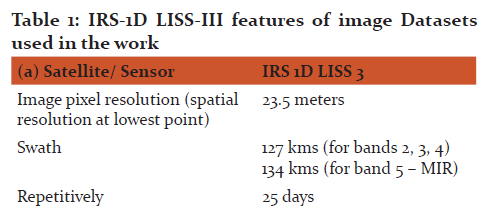
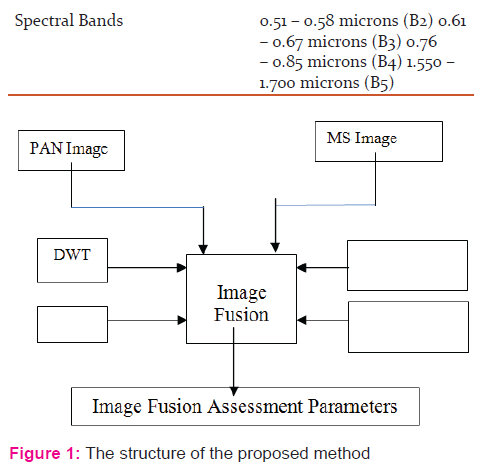
EXPERIMENTAL RESULTS COMPILATION AND DISCUSSIONS
IRS 1D satellite and LISS-III sensor images accomplished from NRSA Hyderabad, India are compiled as input images for image fusion to obtainmore informative fused images. Fused images attained from different fusion methods, DWT, DCT variance, consistency verification with DCT variance and SWT are compared.Fused otcomes are evaluated by entropy, image quality index(IQI), spatial frequency (SF), peak signal to noise ratio (PSNR), standard deviation (SD), mutual information measure (MIM) between fused image and panchromatic, fused image and multi spectral image.
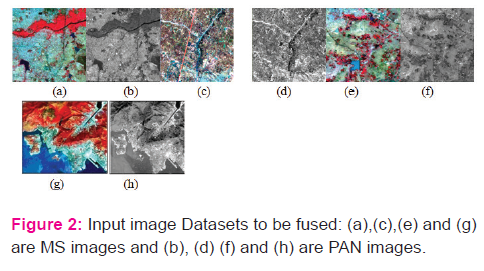
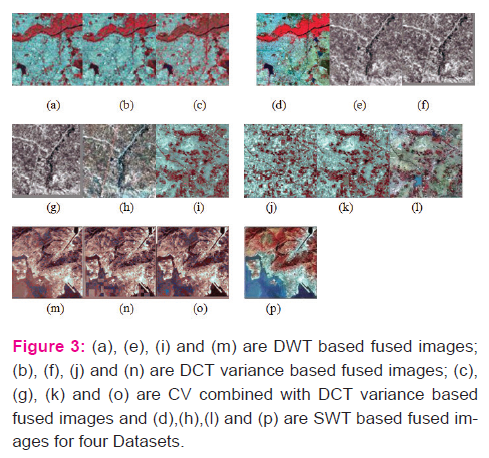
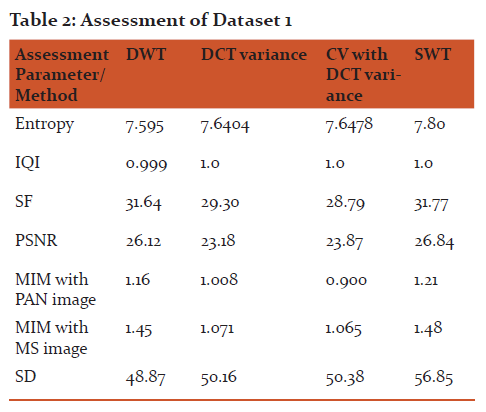
SWT based fused image gives higher values for entropy, IQI and SD values for the Dataset 1 states that information levels, quality evidence and contrast are high for the SWT based fused image compared to DWT and DCT based fused images.
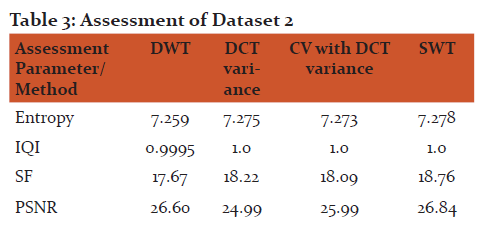

SWT based fused image having better values for entropy, IQI, SF, MIM and SD in
Dataset 4 illustrates that SWT overcomes the drawbacks of other wavelet transform
domains like DWT and DCT.

Potentiality of the SWT produces better values for entropy, IQI, PSNR, MIM and SD designates that SWT performs better fusion compared to other techniques discussed.
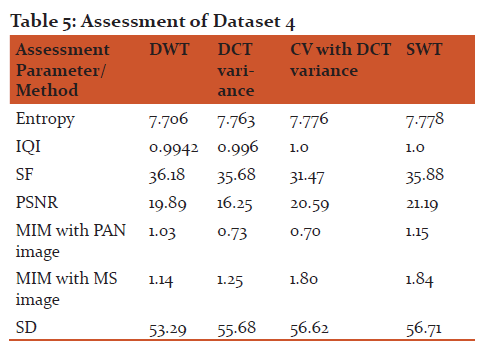
As SWT will not destroy constants at each transformation level SWT based fused image having higher values for entropy, IQI,PSNR, MIM and SD indicates that SWT fusion outperforms DWT and DCT based fusion techniques.
The overall results and discussions have proved that proposed SWT based fusion techniques hav met the objectives of image fusion by improving spectral and spatial information as well
CONCLUSIONS
Image fusion is a technique to converge MS and PAN images or many input images attained through different instruments into a one fused image incorporateshigh spectral and spatial validation. Fused images required in plenteousapplicationsviz image exploration, image indulgent, computer conception, cataloging, image appreciation, remote sensing, medical imaging, biometrics, video supervision. DWT, DCT and SWTimage fusion approaches are implemented here. Fused results are evaluated through varous assessment parameters. Because of the basic property and potentiality of the SWT based fused results outperforms DWT and DCT based fused approaches. After SWT fused results DCT variance and CV with DCT variance based fused results improved fused image content.
ACKNOWLEDGEMENT
Authors acknowledge the immense help received from the scholars whose articles are cited and included in references of this manuscript. The authors are also grateful to authors / editors / publishers of all those articles, journals and books from where the literature for this article has been reviewed and discussed.
References:
[1] Saranya.G. and Nirmala Devi.S,”Performance evaluation for image fusion technique in medical images using spatial and transform method”,2016.
[2] Sejal Baraiya and Lokesh P. Gagnani,” An Introduction of Image Fusion Techniques”, International Journal for Innovative Research in Science & Technology,Vol.1No.7,2014
[3] Tania Sultana, Md. Dulal Hossaina and Md. Karam Newaz,”Analysis on SWT based Image Fusion Techniques using Intuitionistic Fuzzy Set Operations”, International Journal Of Technology Enhancements And Emerging Engineering Research, vol.4, No.8,pp. 16-19,2016.
[4] Rajvi Patel,Manali Rajput and Pramit Parekh“Comparative Study on Multi-focus Image Fusion Techniquesin Dynamic Scene”, IJCa,Vol.109, No.6, Pp.5-9, 2015
[5] P. Mangalraj and Anupam Agrawal,”Fusion of Multi-Sensor Satellite Images using Non-Subsampled Contourlet Transform”, Procedia Compur Science, Vol.54, pp.713-720,2015.
[6] Mansing Rathodand Jayshree Khanapuri“Comparative study of transform domain methods for image resolution enhancement of satellite image”,IEEE xplore,2017.
[7] D.S.Rao,M.Seetha and M.H.M.Krishna Prasad, “Quality assessment of pixel- level image fusion using fuzzy logic, IJSC,ol.3No.1,pp.13-25, 2012.
[8] V.P.S Naidu,” Discrete Cosine Transform based Image Fusion Techniques, Journal of Communication, Navigation and Signal Processing”,Vol.1, No.1, pp.35-45,2012.
Md.Bagher, Akbari, Aghagolzadeh and Seyedarabi,“Multi-focus image fusion for visual sensor networks in DCT domain”,Journal onComputers and Electrical Engineering,Vol.37,No
|






 This work is licensed under a Creative Commons Attribution-NonCommercial 4.0 International License
This work is licensed under a Creative Commons Attribution-NonCommercial 4.0 International License